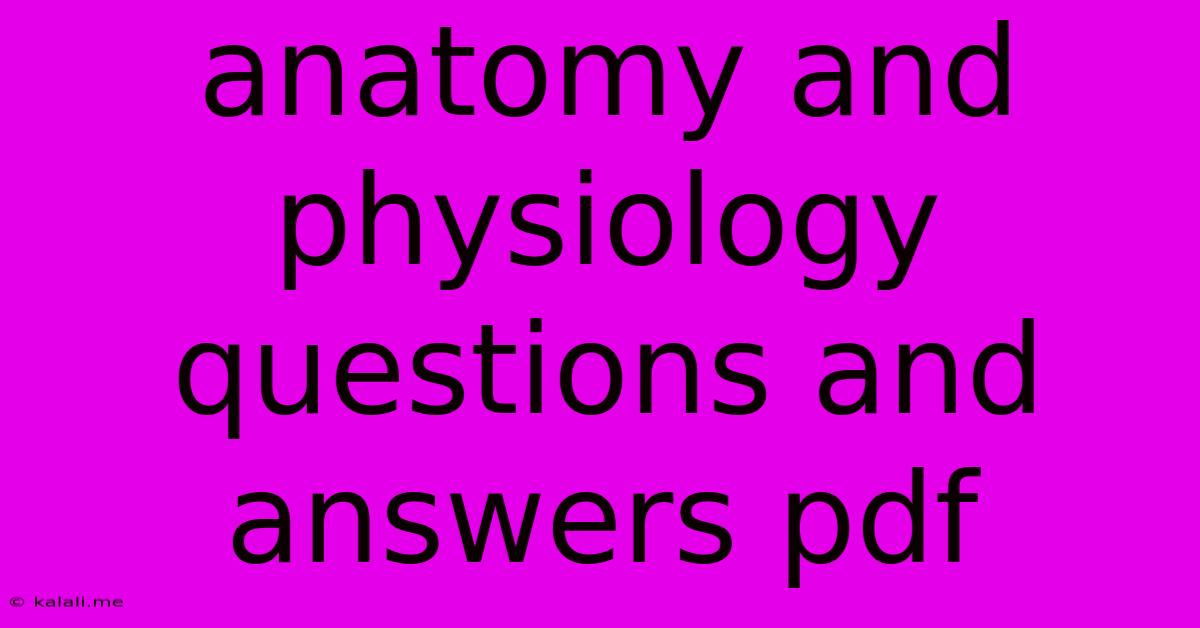Anatomy And Physiology Questions And Answers Pdf
Kalali
Jun 14, 2025 · 3 min read

Table of Contents
Anatomy and Physiology Questions and Answers: A Comprehensive Guide
Meta Description: This article provides a comprehensive overview of common anatomy and physiology questions and answers, perfect for students and anyone looking to deepen their understanding of the human body. We cover key concepts and provide helpful resources for further learning.
Anatomy and physiology is a vast and complex subject, covering the structure and function of the human body. Understanding this intricate system can be challenging, but mastering the fundamentals is crucial for anyone in the medical or health fields, or simply for those curious about how their bodies work. This article aims to address some common questions and provide clear answers, acting as a helpful resource for students and anyone wanting to improve their knowledge. While we can't provide a downloadable PDF (as requested in the title), this comprehensive guide will serve as a valuable alternative.
Key Areas in Anatomy and Physiology
Before delving into specific questions and answers, let's briefly overview the major areas within anatomy and physiology:
- Cell Biology: Understanding the basic unit of life, including cell structure, function, and processes like cell division and metabolism.
- Histology: The study of tissues, including epithelial, connective, muscle, and nervous tissue. Understanding tissue types is essential to grasping organ function.
- Organ Systems: This covers the individual systems of the body, such as the cardiovascular, respiratory, digestive, nervous, endocrine, musculoskeletal, urinary, and integumentary systems. Each system's anatomy and physiology are intricately interconnected.
- Homeostasis: The body's ability to maintain a stable internal environment, despite external changes. This is a core concept in physiology.
Common Anatomy and Physiology Questions & Answers
Here are some frequently asked questions with detailed explanations:
Q1: What is the difference between anatomy and physiology?
A1: Anatomy focuses on the structure of the body – what things look like, where they are located, and how they are organized. Physiology focuses on the function of the body – how things work, what processes occur, and how they interact. They are inseparable; understanding structure is crucial to understanding function, and vice-versa.
Q2: Explain the difference between negative and positive feedback loops.
A2: Negative feedback loops are the most common type of homeostatic control mechanism. They work to counteract changes and return the body to its set point. For example, when body temperature rises, sweating and vasodilation occur to cool the body down. Positive feedback loops, on the other hand, amplify changes. Childbirth is a good example; uterine contractions stimulate more contractions until delivery.
Q3: Describe the role of the nervous system in maintaining homeostasis.
A3: The nervous system plays a critical role in maintaining homeostasis through rapid communication. It uses electrical signals to detect changes in the internal environment (sensory input), process this information (integration), and initiate appropriate responses (motor output) to restore balance. This includes regulating heart rate, blood pressure, and body temperature.
Q4: What are the main components of blood?
A4: Blood consists of plasma (the liquid component), red blood cells (erythrocytes, carrying oxygen), white blood cells (leukocytes, fighting infection), and platelets (thrombocytes, involved in blood clotting).
Q5: Explain the process of cellular respiration.
A5: Cellular respiration is the process by which cells break down glucose to produce ATP (adenosine triphosphate), the body's main energy currency. This involves several stages: glycolysis, the Krebs cycle, and the electron transport chain.
Resources for Further Learning
While this guide provides a starting point, there are many resources available for a deeper dive into anatomy and physiology:
- Textbooks: Many excellent anatomy and physiology textbooks are available at various levels of detail.
- Online Courses: Numerous reputable online platforms offer comprehensive courses in anatomy and physiology, often with interactive elements and quizzes.
- Anatomy Atlases: Visual learning is crucial; using anatomical atlases can greatly enhance understanding.
By understanding the fundamental principles of anatomy and physiology, you gain a profound appreciation for the complexities and marvels of the human body. This article serves as a springboard for further exploration, encouraging continued learning and investigation into this fascinating field. Remember to utilize the various resources available to expand your knowledge and solidify your understanding.
Latest Posts
Latest Posts
-
The Final Product Of Carbohydrate Digestion Is A
Jun 14, 2025
-
What Is The Melting Point Of Carbon
Jun 14, 2025
-
How Many Zeros Are In 1000
Jun 14, 2025
-
Which Of The Following Is Not True About Stress
Jun 14, 2025
-
What Planet Has The Lowest Density
Jun 14, 2025
Related Post
Thank you for visiting our website which covers about Anatomy And Physiology Questions And Answers Pdf . We hope the information provided has been useful to you. Feel free to contact us if you have any questions or need further assistance. See you next time and don't miss to bookmark.